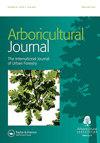Can wound wood’s haptotropic nature be artificially manipulated to utilise edaphoecotropism?
Q3 Agricultural and Biological Sciences
引用次数: 1
Abstract
ABSTRACT Numerous modern dynamic bracing systems are now available throughout the arboricultural industry. These replace the practice of invasive rigid bracing, often shown to weaken structural security through the causation of decay. Furthermore, in historic cases where extensive internal decay develops, the edaphoecotropic occlusion of the bracing system with newer wood provides additional strength to the resulting system. Additionally, it can be shown that wound wood (ww) resulting from cambial damage is stronger and faster growing than average annual growth. This paper explores the concept of inducing ww with the aim of utilising a wood’s haptotropic nature to occlude objects. The findings identified that small longitudinal fenestration wounds >15 mm in width can be occluded within a year with low chance of further dysfunction or decay. The concept was tested by successfully inserting plastic “I” beams [lengths of plastic with a cross section of an “I”, used frequently for hobbyist construction and in this case as they had a winged base and were of the size required] into 1 mm width cambial wounds on a Norway maple (Acer platanoidies), demonstrating that it is possible to utilise induced ww to capture an object without causing lasting damage to the tree.是否可以人为操纵伤口木材的致光性来利用其致光性?
许多现代动态支撑系统现在可以在整个树木工业中使用。这些取代了侵入性刚性支撑的做法,通常通过引起腐蚀而削弱结构安全性。此外,在历史上广泛的内部腐烂发展的情况下,新木材的支撑系统的向光性遮挡为所产生的系统提供了额外的强度。形成层损伤后的伤材比年平均生长量更强,生长速度更快。本文探讨了诱导ww的概念,目的是利用木材的触觉特性来遮挡物体。研究结果表明,宽度>15毫米的小纵向开窗伤口可以在一年内被封闭,进一步功能障碍或腐烂的可能性很低。这个概念是通过成功地将塑料“I”梁(带有“I”横截面的塑料长度,经常用于业余建筑,在这种情况下,它们有一个有翼的底座,并且是所需的尺寸)插入到挪威枫(Acer platanoidies)上1毫米宽的形成层伤口中来测试的,这表明有可能利用诱导www来捕获物体而不会对树木造成持久的损害。
本文章由计算机程序翻译,如有差异,请以英文原文为准。
求助全文
约1分钟内获得全文
求助全文
来源期刊

Arboricultural Journal
Agricultural and Biological Sciences-Agronomy and Crop Science
CiteScore
2.40
自引率
0.00%
发文量
28
期刊介绍:
The Arboricultural Journal is published and issued free to members* of the Arboricultural Association. It contains valuable technical, research and scientific information about all aspects of arboriculture.
 求助内容:
求助内容: 应助结果提醒方式:
应助结果提醒方式:


